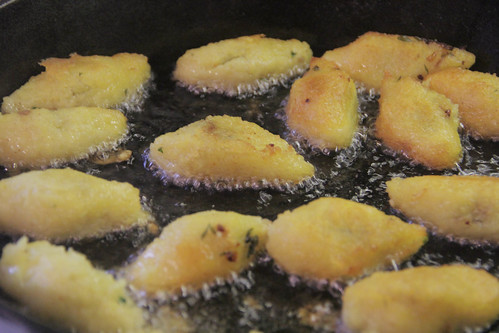 Look beyond the horrible news coming out of the country these days, or the past few decades — way, way beyond, because agriculture and civilization in the lands that now comprise Iraq goes back at least ten thousand years. The soils along the Tigris and Euphrates river are fertile and relatively moist, and the surrounding lands held forth wild grasses that became such staple grains as wheat and barley, and soon after domesticated animals, and writing, and even beer.
Look beyond the horrible news coming out of the country these days, or the past few decades — way, way beyond, because agriculture and civilization in the lands that now comprise Iraq goes back at least ten thousand years. The soils along the Tigris and Euphrates river are fertile and relatively moist, and the surrounding lands held forth wild grasses that became such staple grains as wheat and barley, and soon after domesticated animals, and writing, and even beer.
The cuisine of Iraq has transformed a whole lot over the millennia. While wheat and barley are still to be found, rice is the grain of choice — so beloved that it goes by the word timman, from the now-extinct Akkadian language, rather than the standard Arabic ruz. Beer can be found, but indications are that it's not so great. And other crops have emerged too, with Iraq now the world's largest producer of dates.
While many of the classics of Middle Eastern cuisine are very common on the Iraqi table, such as hummus, baba ghannoush, and kebab, I narrowed the focus to what is, as far as I can tell, most distinctive to the country. In particular, I found abundant reference and a huge variety of recipes for kibbeh, a general term for grain stuffed with meat, and there was no doubt that the "national dish" is a fish split open, rubbed with spices, and slowly grilled, or that I should make a cookie with a nearly savory dough but a very sweet filling for dessert.
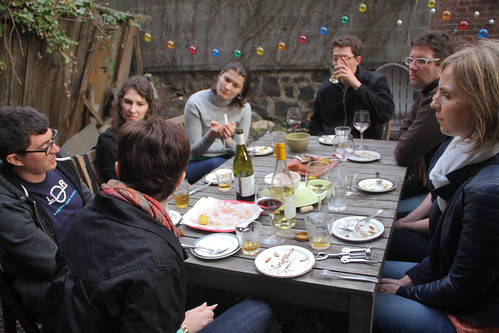
Our guests for the evening were Molly, Stephen, Steve, Yali, Sarah and Shana.
Loomi | Dried lime tea | Recipe
Most things when dried are seen as a fairly equivalently flavored, if sometimes inferior, substitute for the fresh version, like spices or mushrooms or stone fruits. But a very few foods transform into something altogether different after spending some time in the sun: sundried tomatoes have a concentrated richness, it's hard to believe a raisin was once a grape. Limes go through perhaps an even greater metamorphosis: they shrink, turn nearly black, the insides crumble into almost nothing, and they take on a haunting aroma that's smoky, tart, bitter, and perfumey, all in one.
While they can also be used whole in a stew, or ground up into a powder and added to a spice blend, you'll enjoy them in their purest form as an exquisitely refreshing tea. The hardest part of making loomi, as it's known, is finding them, but any Middle Eastern store or a good-enough spice shop will carry them. (Kalustyan's in Manhattan has several varieties of different darkness and size, shades of subtlety I have yet to explore.) Once acquired, it's as simple as poking a few holes in them with a fork, steeping them in water with sugar added, straining, and chilling.
Mutabbal | Eggplant salad | Recipe
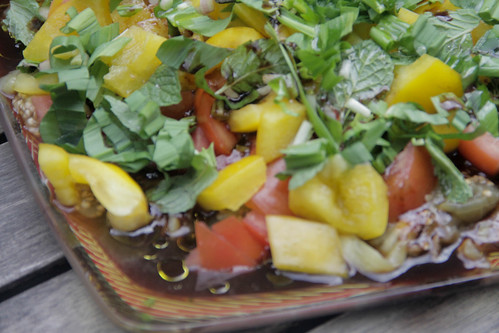
Pretty straightforward: roast an eggplant, dice it up and put over chopped veggies, drizzle with olive oil and pomegranate molasses. Really quite tasty.
Kubba halab | Lamb-stuffed rice croquette | Recipe
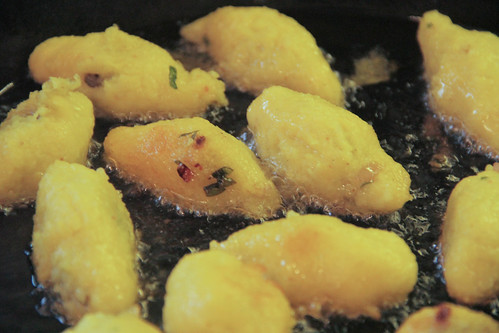
Iraq offers an astonishing variety of meat-stuffed grain. With a few exceptions, such as the Mosul variety which is two thin layers of bulgur with a meat layer in the middle, they are shaped somewhere between a torpedo and an American football, a coating of starch enveloping a meaty core. I chose this one, with a shell of rice and potatoes, in homage to the predominance of rice in the Iraqi cuisine and psyche. (Though, oddly, its name refers to the Syrian city of Aleppo.)
This was a labor-intensive dish. The meat isn't so hard to make but for all the breaking-up of the ground lamb in the frying pan. The outer shell requires cooking both rice and potato, then passing through a meat grinder, before forming into balls that you poke a hole into and smush in just enough lamb but not so much that it bursts. Then you have to freeze the balls to get them firm enough so they don't break apart when being fried in the pan, but even then they sometimes break and a fair amount of the crispy bits stick to the pan rather than the food. It's tasty enough, but maybe I'd recommend the easier Mosul variety!
Masgouf | Grilled butterflied fish | Recipe
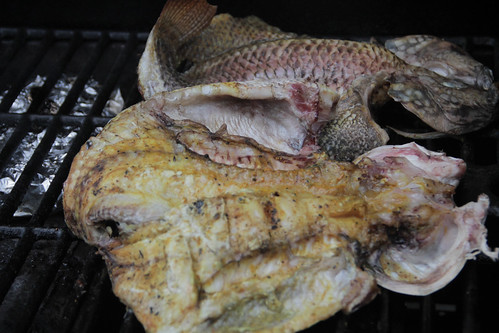
Masgouf is a freshly-killed carp from the Euphrates river, butterflied, rubbed with turmeric and tamarind, and splayed out vertically, its insides exposed to the nearby flames of slowly burning apricot wood. The memory of this dish, languid in the cooking, inspires such wistfulness for better days that it's been the topic of dozens of articles and even a widely distributed fictional book. But now the Euphrates is so polluted that it's a serious risk to eat a carp pulled from it, and the hours of leisure the live-fish-to-smoky-flesh preparation require are too far a luxury to Baghdadis of recent times.
My reasons for not making a true masgouf are purely logistical: I don't have the space or equipment to build such a fire, and none of the shops I went to in Chinatown had carp, so I used tilapia instead. Thankfully they took care of the butterflying for me, and I did my best to replicate a slow smoky fire by using hickory chips on the gas grill and very slowly and indirectly cooking the fish. You know what? It turned out super tasty. The smoke definitely came through, and the odd combination of spices paired nicely with the sweet flesh.
Timin shreya | Vermicelli rice | Recipe

Just like their Eastern neighbors, Iraqis love a crispy crust on their rice. Unlike the Persians, though, Iraqis don't go through an elaborate process of soaking and parboiling the rice and then exaggerating the crust with a layer on the bottom — they just use a bit of fat and a very long, slow cook to get a crispy crust the straightforward way. While putting vermicelli, little strands of pasta, in with the rice isn't necessarily the absolutely most typical presentation, it sure looks nice and adds variety to the presentation. If making this dish, it's really important to make sure the heat is well-diffused. I use a cast iron heat diffuser, but in a pinch you could just place your pot on top of a (not-non-stick) frying pan to make sure the heat really spreads, otherwise you'll get a burnt spot where the heat hits.
Kleicha | Date cookies | Recipe
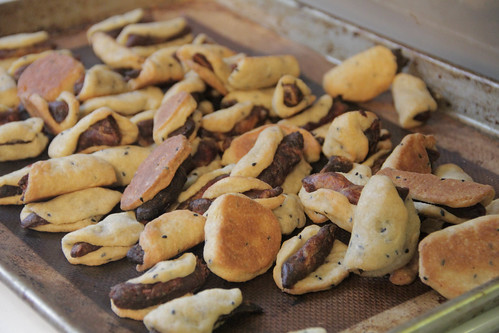
Back when Iraq was a place of diverse religions, Jews and Christians as well as Muslims all would make this dish as a symbol of celebrations both religious and personal. It's not exactly what passes for a cookie in the West — the yeasted dough is decidedly unsweet and it's the filling that makes it dessert, and the whole thing is haunted with spices like generally un-sweet flavors like fennel and nigella — but the crispness and finger-food nature make for a sufficiently apt comparison. While they can be many shapes and filled with many things, the classic filling is dates and the roll-up cookie seems the most common.
These were actually really fun to make. The dates come together nicely, and the dough is so buttery that it's actually a pleasure to work with. And oh, the eating experience! A haunting combo of spices, a delightfully flaky cookie that gives way to a firmly chewy interior, and the perfect size for eating in two nibbles. Goes great with cardamom tea!